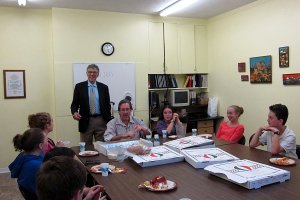September 28, 2013
p. 19 Genesis This is the beginning of a new cycle – all of Ch 1 and the first two verses of Ch 2. The group read the account of all seven days before beginning discussion.
LL: What is the use of “…and each according to its type…” is a constant refrain for all living beings – except for humans. PG: Note the use of “word” as a medium of creation. But there is also a description of God acting as a way of creating. LL: Don’t we create all of the time by naming things? New ideas and scientific advancements require new language . Every word is the embodiment of an idea. PG: This the Greek logos. LL: To me these passages describe the advent of language. PG: Consider the use of the noun “rose.” “I saw a rose, I saw the rose, and I saw Rose. It is the particle “et” in Hebrew that is used to make the same distinction between a definite and indefinite object. It is a marker or grammatical indicator that is often found in an elite language. Similarly the Hebrew “Brachit” is not really translatable into English. SF: So what was the intent of all of this vagueness? We have indefinite time and indefinite object. The entire lesson of Torah is contained in this first sentence – creation of the world out of love and compassion. The vagueness gives rise to all of our analysis and discussion. PG: Both science and philosophy have asked the question of what was “before.” The conventional notion of “before” is a reference to prior to the Big Bang. Maimonides pointed out that the idea that there was anything before is merely an assertion – an article of faith. But is there a compelling reason to believe? Yes, because otherwise we have no authoritative God who is promoting what is “good.” The Gospel of John starts “in the beginning there was the word.” which was a powerful defense of the authority of Jesus. He spoke authoritatively and was given that authority by The Word.
Next year we will take up the second creation story – Adam and Eve.
The New English Bible uses the phrase “In the beginning of creation…”
2:4 The chronicle of heaven and earth. As to the Greek “chromos” see: http://en.wikipedia.org/wiki/Chronos
PG: Ultimately we can talk about this universe or others. The text leaves everything open. AC: This is like where a child looks to a parent for explanations and the lesson is that they must learn to live with indecisiveness and uncertainty. PG: Darwin was easily accepted by mainstream religion during the 19th C. It wasn’t until later that the strict creationists rejected Darwin. Religion and science are frequently reconcilable. Consider the end Carl Sagan’s book “Contact” wherein he purports to find a recurring sequence within Pi. See: http://www.carlsagan.com/ and http://en.wikipedia.org/wiki/Carl_Sagan
Regarding the relationship between religion and science, Sagan stated: “Science is not only compatible with spirituality; it is a profound source of spirituality. When we recognize our place in an immensity of light-years and in the passage of ages, when we grasp the intricacy, beauty, and subtlety of life, then that soaring feeling, that sense of elation and humility combined, is surely spiritual.
LL/






